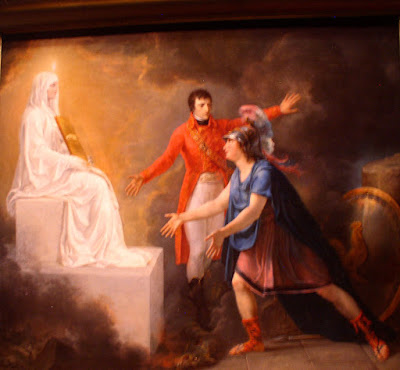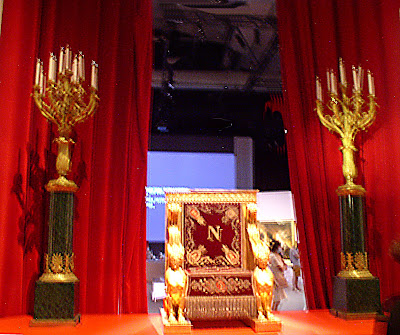PARC DE LA VILLETTE EXHIBITION May 28 - December 19, 2021
The Grand Hall at Parc de la Villette
Ticket office for exhibition
Detail, Napoleon crossing the Alps by Jacques-Louis David
Longtime friends, Phyllis and Bob, sitting on the Fontaines aux Lions de Nubie in front of the Grand Hall
MILITARY EDUCATION
Napoleon, one of the most celebrated personages in the history of the West, was born on August 15, 1769, in French-occupied Corsica. Napoleon’s father strongly supported Corsican independence, but ultimately sided with France. This move allowed his sons, Joseph and Napoleon to enroll in the French College d’Autun. After a few years, Napoleon was admitted to a military college in Brienne, which he attended for five years. He then transferred to the military academy in Paris.
Napoleon at Brienne
Young Napoleon studying
Napoleon graduated from the Parisian military academy, gained a commission as an artillery officer and returned to Corsica in 1786. After a falling-out with a Corsican resistance leader, Napoleon and his family moved to France.
FRENCH REVOLUTION
During the years of the French Revolution (1789-1799), Napoleon initially supported the Jacobins, a far-left political movement. In 1792, France was declared a republic; a year later Louis XVI was executed, the Jacobins fell from power, and Robespierre became the leader of the Directory (French Revolutionary Government.) The years 1793 and 1794 are known as the Reign of Terror, when as many as 40,000 people were executed. (Eventually, Robespierre was guillotined, too.) The French Revolution began not only as a revolt against the monarchy but had a strong anti-clerical streak as well.
NAPOLEON’S RISE TO POWER
In 1795, the Directory took control of the country. Napoleon became a favored son after he saved the government from counter-revolutionary forces. Napoleon was named commander of the Army of the Interior. In 1796, he took command of the Army of Italy. The reinvigorated army won crucial victories against the Austrians, expanded the French empire and suppressed an internal threat by the royalists, who wished to return France to a monarchy. Napoleon was a shining star. He married Josephine de Beauharnais on March 9, 1796.
NAPOLEON IN EGYPT
Eager to get rid of this potential challenger, the Directory agreed to let Napoleon take an army on an Egyptian campaign to capture Egypt and hamper British shipping to India. On July 1, Napoleon and his army went to the Middle East to undermine Great Britain’s empire by occupying Egypt and disrupting English trade routes to India.
Bivouac of Napoleon in Egypt
Battle of Arcole, November, 1796
The French Army of Italy won a victory over the Italian army.
Napoleon at the Pont d’Arcole, 1797
The painting by Antoine-Jean Gros showed an episode during the battle of Arcole with Napoleon leading his troops to storm the bridge.
Horse armor
Uniform
Camel
Battle of the Pyramids, July, 1798
A major engagement during the French invasion of Egypt
Detail, Battle of the Pyramids
However, Napoleon's campaign in Egypt did not go as planned. On August 1, Admiral Horatio Nelson’s fleet decimated Napoleon’s forces in the Battle of the Nile, August, 1798, and when Napoleon heard that the Directory was losing power, he abandoned his army and rapidly returned to Paris to take advantage of the situation.
FIRST CONSUL
Following his 1799 return to France, Napoleon participated in an event known as the “Coup de Brumaire,” a bloodless coup d’état that overthrew the French Directory. The coup resulted in the replacement of the existing government body, a five-member Directory, by a three-person Consulate. Napoleon became the first of three consuls in the new government proclaimed in 1799.
Napoleon Crossing the Alps through Great Saint-Bernard Pass, May, 1800
As First Consul, Napoleon began a program to consolidate his power. He ended the current rift between France and the Church by instituting the Concordat of 1801. He signed a concordat with Pope Pius VII, which helped bring religion back to France after the Revolution.
In 1802, Napoleon signed the Peace of Amiens, a temporary peace with the British. In order to be able to concentrate solely on his European affairs, he sold France's Louisiana territory to the U.S. in 1803. And in 1804, he set the foundation for much of Europe's legal system by establishing the Napoleonic Code.
First Consul reconciling the Catholic Church and France post-revolution
EMPEROR NAPOLEON
In 1804, Napoleon did away with the Consulate and crowned himself Emperor in an extravagant coronation ceremony at Notre Dame Cathedral. He decreed himself Emperor because he believed the security of the regime depended on a hereditary line of succession. He also crowned Josephine Empress.
Mantel
NAPOLEONIC WARS
The Napoleonic Wars were a series of European wars lasting from 1803 to Napoleon’s second abdication in 1815. In 1805, Napoleon was planning an invasion of England when the Russian and Austrian armies began marching towards France. Napoleon's forces defeated them at Austerlitz, but not before the British fleet had destroyed Napoleon's navy at Trafalgar. At this time, Napoleon expanded his Empire by creating the Confederation of the Rhine in Germany and the Grand Duchy of Warsaw in Poland. By now, Napoleon controlled almost all of Western Europe with the exception of Spain. He decided to try and destroy the economy of his major enemy, Britain, by instituting the Continental System, under which all European ports would refuse to accept British shipments. He failed in this task, and in trying to force Spain to comply, touched off the Peninsular War.
Surrender at Ulm, October 1805
Detail, Surrender at Ulm
Napoleon trapped an entire Austrian army with minimal losses and forced its surrender near Ulm in Bavaria.
Battle of Austerlitz, December, 1805
A significant victory for Napoleon. His 68,000 troops defeated 90,000 Russian and Austrian combined forces.
Battle of Eylau, February, 1807
The victory was won at a very great cost to Napoleon, and he was no longer considered invincible.
MARIE-LOUISE
In 1810, Josephine, although the mother of two children by her previous husband, had not yet provided Napoleon with any heirs; distressed by this, he had his marriage to her annulled. Napoleon had met the 18-year-old Austrian archduchess Marie-Louise at a ball given by Talleyrand in Warsaw in 1807. They had an affair and had a son, Napoleon II, known as “the King of Rome.”
Marie-Louise
Marriage ceremony of Napoleon and Marie-Louise
Marriage coach April 2, 1810
DECLINE OF THE EMPIRE
Around this time, Czar Alexander I withdrew Russia from the Continental System. In 1812, Napoleon's Grand Army entered Russia in order to punish Alexander, but the ravages of the deadly Russian winter decimated his army. From a force of 600,000 men, there remained 10,000 still fit for battle. This failure was the beginning of the end for Napoleon and emboldened his enemies, both inside and outside of France.
EXILE
Scene from the Russian campaign
Battle of Waterloo, June 18, 1815
Abdication
Despite raising a new army, Napoleon was defeated by a coalition of European forces at Leipzig in 1814. Napoleon surrendered to allied forces on March 30, 1814. He was forced to abdicate power and went into exile on the island of Elba in the Mediterranean Sea off of Italy. Once there, he proceeded to plot his return.
Return from Elba
Napoleon escaped from Elba, sneaked into France, and raised a new army in the period known as the Hundred Days. In June, 1815, the armies of Wellington and Blucher defeated Napoleon at Waterloo. Napoleon was again exiled.
Caisson --the casket of Napoleon in a military funeralThis time, fearing a repeat of his earlier return from exile on Elba, the British government sent him to the remote island of Saint Helena in the South Atlantic. He died there on May 5, 1821 at the age of 51.
Sculpture of Napoleon overlooking the courtyard of Les Invalides
Last Moments, marble sculpture by Vincent Vela, 1866
Napoleon is seated in a chair supported by a pillow. A blanket covers his body and legs, but his dressing gown, partly open, shows his massive but wasted chest. His head droops forward as if yielding to the last conqueror, Death.
Napoleon’s tomb is in Paris at Les Invalides, once a home for disabled veterans, now a landmark in Paris.





































No comments:
Post a Comment